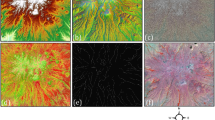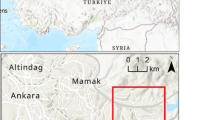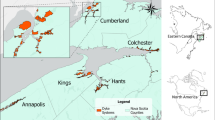Abstract
Landform detection and analysis from Digital Elevation Models (DEM) of the Earth has been boosted by the availability of high-quality public data sets. Current landform identification methods apply heuristic algorithms based on predefined landform features, fine tuned with parameters that may depend on the region of interest. In this paper, we investigate the use of Deep Learning (DL) models to identify mountain summits based on features learned from data examples. We train DL models with the coordinates of known summits found in public databases and apply the trained models to DEM data obtaining as output the coordinates of candidate summits. We introduce two formulations of summit recognition (as a classification or a segmentation task), describe the respective DL models, compare them with heuristic methods quantitatively, illustrate qualitatively their performances, and discuss the challenges of training DL methods for landform recognition with highly unbalanced and noisy data sets.

















Similar content being viewed by others
Notes
All the 3D terrain images in this Section are generated using the CesiumJS toolFootnote 7.
References
Audebert N, Le Saux B, Lefèvre S (2016) Semantic segmentation of earth observation data using multimodal and multi-scale deep networks. In: Asian Conference on Computer Vision. Springer, pp 180–196
Bandura P (2016) Multi-scale landform-based identification of mountain peaks from DEMs in Slovakia
Beckham C, Pal C (2017) A step towards procedural terrain generation with GANs. arXiv:170703383
Chaudhry O, Mackaness W (2008) Creating mountains out of mole hills: automatic identification of hills and ranges using morphometric analysis. Transactions in GIS 12, https://doi.org/10.1111/j.1467-9671.2008.01116.x
Chen Z, Wang X, Xu Z et al (2016) Convolutional neural networks based DEM super resolution. International Archives of the Photogrammetry, Remote Sensing & Spatial Information Sciences, pp 41
De Jong C, Barth T (2008) Challenges in hydrology of mountain ski resorts under changing climatic and human pressures. Surface Water Storage and Runoff: Modeling, In-Situ data and Remote Sensing Genève, ESA Proceedings
Defferrard M, Bresson X, Vandergheynst P (2016) Convolutional neural networks on graphs with fast localized spectral filtering. In: Advances in Neural Information Processing Systems
Deng Y, Wilson J (2008) Multi-scale and multi-criteria mapping of mountain peaks as fuzzy entities. Int J Geogr Inf Sci 22(2):205–218
Evans IS (2012) Geomorphometry and landform mapping: what is a landform? Geomorphology 137(1):94–106
Farr TG, Kobrick M (2000) Shuttle radar topography mission produces a wealth of data. Eos Trans Amer Geophys Union 81(48):583–585
Fedorov R, Camerada A, Fraternali P, Tagliasacchi M (2016) Estimating snow cover from publicly available images. IEEE Trans Multimed 18(6):1187–1200
Fisher P, Wood J (1998) What is a mountain? Or the Englishman who went up a Boolean geographical concept but realised it was fuzzy. Geography 83(3):247–256
Fisher P, Wood J, Cheng T (2004) Where is Helvellyn? Fuzziness of multi-scale landscape morphometry. Trans Inst Br Geogr 29(1):106–128
Fisher P, Wood J, Cheng T (2005) Fuzziness and ambiguity in multi-scale analysis of landscape morphometry. In: Fuzzy modeling with spatial information for geographic problems. Springer, pp 209–232
Frėnay B, Verleysen M (2014) Classification in the presence of label noise: a survey. IEEE Trans Neural Netw Learn Syst 25(5):845–869
Fry S (1987) Defining and sizing-up mountains. Summit
Girshick R (2015) Fast r-cnn. In: Proceedings of the IEEE International Conference on Computer Vision, pp 1440–1448
Graff LH, Usery EL (1993) Automated classification of generic terrain features in digital elevation models. Photogr Eng Remote Sens 59(9):1409–1417
Guérin E, Digne J, Galin E, Peytavie A, Wolf C, Benes B, Martinez B (2017) Interactive example-based terrain authoring with conditional generative adversarial networks. ACM Trans Graph (TOG) 36(6):228
Guo Y, Liu Y, Oerlemans A, Lao S, Wu S, Lew MS (2016) Deep learning for visual understanding: a review. Neurocomputing 187:27–48
Hastings J (2008) Automated conflation of digital gazetteer data. Int J Geogr Inf Sci 22(10):1109–1127
Hu X, Yuan Y (2016) Deep-learning-based classification for DTM extraction from ALS point cloud. Remote Sens 8(9):730
Jasiewicz J, Stepinski TF (2013) Geomorphons a pattern recognition approach to classification and mapping of landforms. Geomorphology 182:147–156
Kirmse A, de Ferranti J (2017) Calculating the prominence and isolation of every mountain in the world. Prog Phys Geogr 41(6):788–802
Klingseisen B, Metternicht G, Paulus G (2008) Geomorphometric landscape analysis using a semi-automated GIS-approach. Environ Modell Softw 23(1):109–121
Körner C, Jetz W, Paulsen J, Payne D, Rudmann-Maurer K, Spehn EM (2017) A global inventory of mountains for bio-geographical applications. Alpine Botany 127(1):1–15
LeCun Y, Boser B, Denker JS, Henderson D, Howard RE, Hubbard W, Jackel LD (1989) Backpropagation applied to handwritten zip code recognition. Neural Comput 1(4):541–551
LeCun Y, Boser BE, Denker JS, Henderson D, Howard RE, Hubbard WE, Jackel LD (1990) Handwritten digit recognition with a back-propagation network. In: Advances in neural information processing systems, pp 396–404
LeCun Y, Jackel L, Bottou L, Brunot A, Cortes C, Denker J, Drucker H, Guyon I, Muller U, Sackinger E et al (1995) Comparison of learning algorithms for handwritten digit recognition. In: International Conference on Artificial Neural Networks, Perth, Australia, vol 60, pp 53–60
LeCun Y, Bottou L, Bengio Y, Haffner P (1998) Gradient-based learning applied to document recognition. Proc IEEE 86(11):2278–2324
LeCun Y, Bengio Y, Hinton G (2015) Deep learning. Nature 521(7553):436
Lei Ma XZYYGY, Yu L, Johnson BA (2019) Deep learning in remote sensing applications: a meta-analysis and review. Elsevier ISPRS J Photogr Remote Sens 152:166–177
Li W, Zhou B, Hsu CY, Li Y, Ren F (2017) Recognizing terrain features on terrestrial surface using a deep learning model: an example with crater detection. In: Proceedings of the 1st Workshop on Artificial Intelligence and Deep Learning for Geographic Knowledge Discovery. ACM, pp 33–36
Li W, Hsu CY (2018) Automated terrain feature identification from remote sensing imagery: a deep learning approach, Int J Geogr Inf Sci, 1–24
Long J, Shelhamer E, Darrell T (2015) Fully convolutional networks for semantic segmentation. In: Proceedings of the IEEE Conference on Computer Vision and Pattern Recognition, pp 3431–3440
Mao X, Shen C, Yang YB (2016) Image restoration using very deep convolutional encoder-decoder networks with symmetric skip connections. In: Advances in neural information processing systems, pp 2802–2810
Marmanis D, Adam F, Datcu M, Esch T, Stilla U (2015) Deep neural networks for above-ground detection in very high spatial resolution digital elevation models. ISPRS Annals of the Photogrammetry. Remote Sens Spatial Inf Sci 2(3):103
Marmanis D, Wegner JD, Galliani S, Schindler K, Datcu M, Stilla U (2016) Semantic segmentation of aerial images with an ensemble of cnns. ISPRS Ann Photogr Remote Sens Spatial Inf Sci 3:473
Masouleh MK, Shah-Hosseini R (2019) A hybrid deep learning–based model for automatic car extraction from high-resolution airborne imagery. Applied Geomatics:1–13. https://link.springer.com/article/10.1007/s12518-019-00285-4
Podobnikar T (2009) Method for determination of the mountain peaks. In: 12th AGILE International Conference on Geographic Information Science
Podobnikar T (2010) Mountain peaks determination supported with shapes analysis. Geographia Technica 5 (2010):111–119
Podobnikar T (2012) Detecting mountain peaks and delineating their shapes using digital elevation models, remote sensing and geographic information systems using autometric methodological procedures. Remote Sens 4 (3):784–809
Riley SJ, DeGloria S, Elliot R (1999) Index that quantifies topographic heterogeneity. Int J Sci 5 (1-4):23–27
Romero BE, Clarke KC (2018) Exploring uncertainties in terrain feature extraction across multi-scale, multifeature, and multi-method approaches for variable terrain. Cartography and Geographic Information Science 45(5):381–399
Ronneberger O, Fischer P, Brox T (2015) U-net: convolutional networks for biomedical image segmentation. In: Navab N, Hornegger J, Wells WM, Frangi AF (eds) Medical image computing and computer-assisted intervention – MICCAI, vol 2015. Springer International Publishing, Cham, pp 234–241
Saha K, Wells NA, Munro-Stasiuk M (2011) An object-oriented approach to automated landform mapping: a case study of drumlins. Comput Geosci 37(9):1324–1336
Saito T, Rehmsmeier M (2015) The precision-recall plot is more informative than the ROC plot when evaluating binary classifiers on imbalanced datasets. PloS one 10(3):e0118432
Saljoughi BS, Hezarkhani A (2018) A comparative analysis of artificial neural network (ANN), wavelet neural network (WNN), and support vector machine (SVM) data-driven models to mineral potential mapping for copper mineralizations in the Shahr-e-Babak region, Kerman, Iran. Appl Geomat 10(3):229–256
Sathyamoorthy D (2014) Computation of spatial significance of mountain objects extracted from multiscale digital elevation models. In: IOP Conference Series: Earth and Environmental Science, IOP Publishing, vol 20, pp 012044
Schillaci C, Braun A, Kropáček J (2016) 2.4. 2. Terrain analysis and landform recognition. In: Geomorphological techniques (online edition), British Society for Geomorphology
Smith B, Mark DM (2003) Do mountains exist? Towards an ontology of landforms. Environ Plann B: Plann Des 30(3):411–427
Smith MJ, Clark CD (2005) Methods for the visualization of digital elevation models for landform mapping. Earth Surf Process Landf 30(7):885–900
Torres RN, Frajberg D, Faternali P, Herrera S (2018a) Crowdsourcing landforms for open GIS enrichment. In: The IEEE International Conference on Data Science and Advanced Analytics (DSAA)
Torres RN, Fraternali P, Milani F, Frajberg D (2018b) A deep learning model for identifying mountain summits in digital elevation model data. In: 2018 IEEE First International Conference on Artificial Intelligence and Knowledge Engineering (AIKE). IEEE, pp 212–217
Torres RN, Milani F, Fraternali P (2019) Algorithms for mountain peaks discovery: a comparison. In: The 34th ACM/SIGAPP Symposium on Applied Computing. ACM
Vapnik VN (1999) An overview of statistical learning theory. IEEE Trans Neural Netw 10(5):988–999
Wood J (1996) The geomorphological characterisation of digital elevation models
Wood J (2009) Geomorphometry in landserf. Dev Soil Sci 33:333–349
Zeiler MD, Fergus R (2014) Visualizing and understanding convolutional networks. In: European Conference on Computer Vision. Springer, pp 818–833
Zhang L, Zhang L, Du B (2016) Deep learning for remote sensing data: a technical tutorial on the state of the art. IEEE Geosci Remote Sens Mag 4(2):22–40
Zhu XX, Tuia D, Mou L, Xia GS, Zhang L, Xu F, Fraundorfer F (2017) Deep learning in remote sensing: a comprehensive review and list of resources. IEEE Geosci Remote Sens Mag 5(4):8–36
Author information
Authors and Affiliations
Corresponding author
Rights and permissions
About this article
Cite this article
Torres, R.N., Fraternali, P., Milani, F. et al. Mountain summit detection with Deep Learning: evaluation and comparison with heuristic methods. Appl Geomat 12, 225–246 (2020). https://doi.org/10.1007/s12518-019-00295-2
Received:
Accepted:
Published:
Issue Date:
DOI: https://doi.org/10.1007/s12518-019-00295-2




